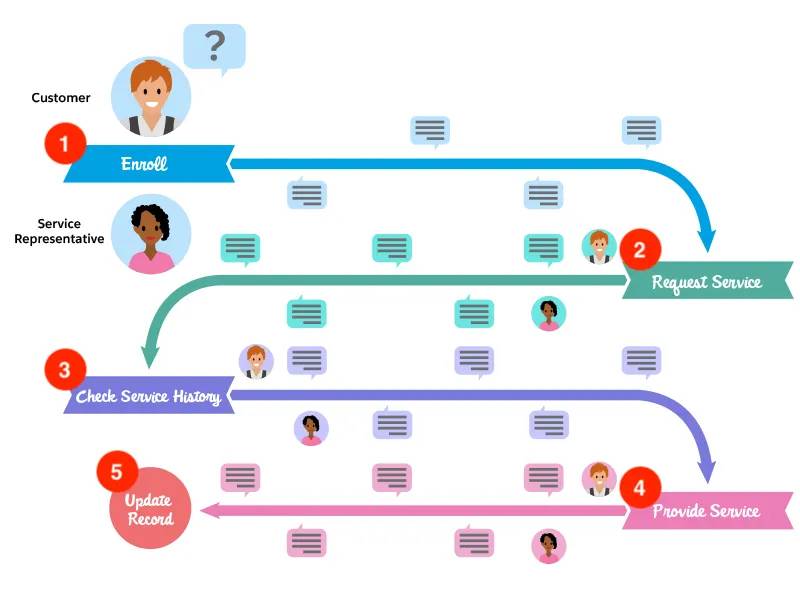Add Journey Mapping to Your Solution Toolbox
Learning Objectives
After completing this unit, you’ll be able to:
- Explain the connection between Relationship Design and journey mapping.
- Explain what a journey map is.
- Explain the benefits of journey mapping.
Strengthen Your Relationship with Customers
At the heart of any solution is your intention to make your customers’ lives better, whether the software you’re building is intended to boost productivity or create a delightful shopping experience. And that’s the core of Relationship Design—the creation of experiences that foster ongoing engagement and strengthen connections between people, companies, and communities.
By itself, that’s a lofty idea. It takes time and effort to home in on what your company can do to make these connections a reality. This is where journey mapping comes in.
What Is a Journey Map?
Journey maps are documents that visually illustrate the experiences customers have with a business or an organization. A journey map identifies several things.
- Steps or activities a customer or user takes to accomplish a goal
- Challenges they face in accomplishing their goal
- People they interact with in a single organization or in an ecosystem of organizations
- Touchpoints and channels—like devices and apps—they encounter as they accomplish a goal
- Feelings, thoughts, and reactions they have throughout their journey
As you can imagine, there are highs and lows in every customer journey. The combination of all of these highs and lows can make—or break—the customer experience.
Follow the Customer
Below is an illustration of a journey map. We dive deeper into creating one that’s relevant for your needs later in this module. The key point here is that a journey map captures these steps from the point of view of the customer or user.

In this example, the journey map follows a customer engaging with a company’s service department. After enrollment in a subscription service, the customer soon has a request. The journey map outlines the steps and interactions the customer goes through to get their request fulfilled.
After enrollment (1), the customer calls with a question (2). Next, the service representative opens a request for service and sends them an email confirmation. Meanwhile, the representative checks the customer’s service history (3), provides the service (4), and then the customer’s record is updated and reflected in an online portal (5), which the customer can view.
Throughout this process, there may be many touch points between the customer and a service representative. That representative might also be collaborating with other colleagues in sales to get details about previous conversations they’ve had with the customer, or operations to get an approval for special pricing, and so on. The journey map captures all this and more—if it affects the customer and can make the difference between a delightful experience and a terrible one, it’s important to capture it.
This also means that there can be many people involved in mapping the customer journey.
Call in the Team
It’s easy to get focused on our individual roles and how they affect the customer. At times we may also think that some of the things we do aren’t impactful. The journey map is good at helping you understand everything the customer experiences. The map can also demystify how each role in the company affects the customer at one point or another and why it’s important to collaborate.
For solutions based on Salesforce, admins, architects, designers, developers, marketers, and more have a stake in mapping out the customer journey for a new feature. So we recommend that you host a workshop with a cross-functional team to get everyone’s perspective. We cover workshop logistics later in this module.
Know the Benefits of Journey Mapping
When you map out the customer journey, you set your team up to build a successful solution. Here are some of the benefits.
-
Better team alignment: Expose how the work of different teams, like sales and service or design and community, come together. It also helps disparate teams speak in a common language about the customer.
-
Strategic thinking: Promote strategic conversations about where to invest your company’s resources and effort for the highest impact.
-
Deeper understanding of customer pain points: Expose gaps, places where the flow isn’t as smooth as it could be, and moments of vulnerability or dissatisfaction for your customers.
-
Increased empathy: Increase empathy for your audience’s experience by assessing your customer’s expectations and emotions as they move through their journey.
-
A strong case for innovation: Expose the innovation work that needs to be done, and discover what matters most to customers.
-
A guide to measuring impact: Model changes in current customer experience, analyze each change’s potential for impact, and model new experiences before they are officially designed.
Ultimately, the journey map helps you craft a vision for the customer that the entire organization can support. It helps you bring together your business objectives with the customer experience.
In the next unit, you get started mapping out the customer journey by identifying the purpose and goals of your solution and working through how to structure your journey map.